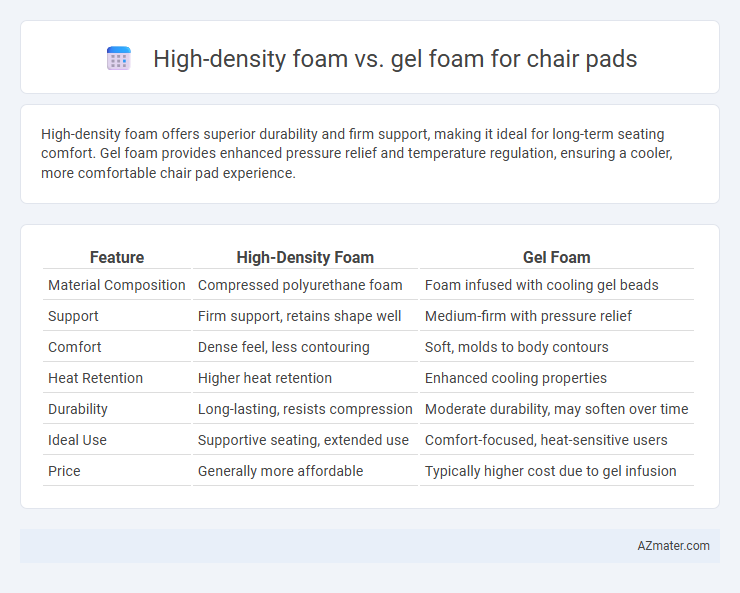High-density foam offers superior durability and firm support, making it ideal for long-term seating comfort. Gel foam provides enhanced pressure relief and temperature regulation, ensuring a cooler, more comfortable chair pad experience.
Table of Comparison
| Feature | High-Density Foam | Gel Foam |
|---|---|---|
| Material Composition | Compressed polyurethane foam | Foam infused with cooling gel beads |
| Support | Firm support, retains shape well | Medium-firm with pressure relief |
| Comfort | Dense feel, less contouring | Soft, molds to body contours |
| Heat Retention | Higher heat retention | Enhanced cooling properties |
| Durability | Long-lasting, resists compression | Moderate durability, may soften over time |
| Ideal Use | Supportive seating, extended use | Comfort-focused, heat-sensitive users |
| Price | Generally more affordable | Typically higher cost due to gel infusion |
Introduction to Chair Pad Materials
High-density foam offers firm support and durability, making it ideal for chair pads that require long-lasting cushioning and pressure distribution. Gel foam combines the supportive qualities of high-density foam with a cooling gel layer, enhancing comfort by regulating temperature and reducing heat buildup. Both materials are popular choices for ergonomic chair pads, addressing different user preferences in comfort and performance.
What is High-Density Foam?
High-density foam is a type of polyurethane foam characterized by its higher weight per cubic foot, typically ranging from 1.8 to 2.5 pounds per cubic foot, which provides enhanced durability and support. It offers excellent cushioning by maintaining its shape under pressure, making it ideal for chair pads that require long-lasting comfort and resistance to sagging. Compared to gel foam, high-density foam delivers firmer support, while gel foam incorporates cooling properties for temperature regulation.
What is Gel Foam?
Gel foam is a specialized cushioning material infused with gel beads designed to enhance pressure relief and temperature regulation in chair pads. Unlike traditional high-density foam, gel foam adapts to body contours while dissipating heat, providing a cooler and more comfortable seating experience. This makes gel foam an ideal choice for prolonged sitting periods where both support and comfort are essential.
Comfort Comparison: High-Density vs Gel Foam
High-density foam offers firm support and excellent durability, maintaining its shape under prolonged use, ideal for individuals seeking consistent comfort and posture alignment. Gel foam provides superior pressure relief by evenly distributing weight and incorporating cooling properties that reduce heat buildup during extended sitting periods. Comparing comfort, gel foam excels in temperature regulation and softness, while high-density foam delivers long-lasting structural support for enhanced seating stability.
Durability and Longevity
High-density foam offers superior durability and retains its shape longer under constant pressure, making it ideal for chair pads subjected to daily use. Gel foam combines comfort with moderate durability but tends to compress faster over time, reducing its longevity compared to high-density foam. Choosing high-density foam ensures better long-term support and resistance to wear in chair pads.
Temperature Regulation and Breathability
High-density foam provides firm support and retains heat, making it less effective for temperature regulation and breathability in chair pads. Gel foam incorporates cooling gel particles that dissipate heat better and enhance airflow, improving comfort during prolonged sitting. For users prioritizing temperature regulation and breathability, gel foam chair pads offer superior thermal management over traditional high-density foam.
Support and Pressure Relief
High-density foam provides firm support and maintains shape under prolonged use, making it ideal for weight distribution and spinal alignment in chair pads. Gel foam integrates cooling gel beads that enhance pressure relief by contouring to body curves and reducing heat buildup, offering superior comfort during extended sitting periods. Choosing between them depends on the need for sustained firmness with durability or enhanced pressure cushioning combined with temperature regulation.
Cost Differences
High-density foam chair pads typically cost less than gel foam options due to simpler manufacturing processes and lower material expenses. Gel foam pads incorporate cooling gel layers and advanced polymer blends, increasing production costs and retail prices. Consumers prioritizing budget-friendly cushioning often choose high-density foam, while those seeking enhanced comfort and temperature regulation invest in more expensive gel foam chair pads.
Ideal Use Cases for Each Type
High-density foam chair pads offer excellent support and durability, making them ideal for long hours of sitting in office or gaming chairs where consistent firmness is required. Gel foam chair pads excel in pressure relief and temperature regulation, making them perfect for users seeking enhanced comfort and cooler seating during extended use or in warm environments. Choosing between these materials depends on whether the priority is firm support or adaptive comfort for prolonged sitting sessions.
Which Chair Pad Material is Best for You?
High-density foam chair pads offer superior support and durability, ideal for prolonged sitting and reducing pressure points, while gel foam pads provide enhanced cooling and comfort by distributing body heat evenly. Choosing the best chair pad material depends on your specific needs: if you require firm support and long-lasting cushioning, high-density foam is preferable; if you seek temperature regulation and softness, gel foam is a better option. Both materials improve sitting ergonomics, but prioritizing comfort or support will guide your optimal chair pad choice.

Infographic: High-density foam vs Gel foam for Chair pad
 azmater.com
azmater.com